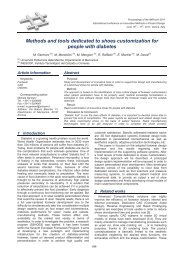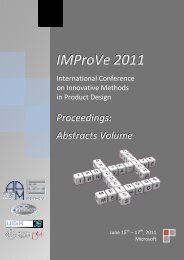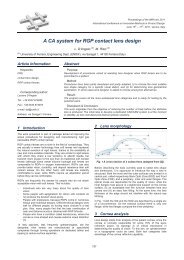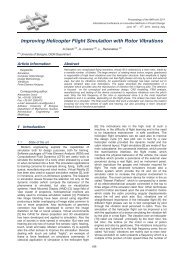IMProVe 2011 - Proceedings
IMProVe 2011 - Proceedings
IMProVe 2011 - Proceedings
Create successful ePaper yourself
Turn your PDF publications into a flip-book with our unique Google optimized e-Paper software.
Reverse Engineering<br />
In the mechanical field agile production requires rapid and flexible shop-floor control<br />
techniques in order to verify the manufacturing operations effectiveness. To accomplish<br />
this goal, 3D scanning systems are evermore used for quality control purposes. Generally,<br />
3D CAD (Computer Aided Design) product models can be used as reference in order to<br />
manage the verification process. The geometrical information represented in the 3D CAD<br />
model can be used in order to virtually plan, simulate and pilot the inspection process.<br />
Even if many methods have been developed to support view planning from known 3D CAD<br />
models, it is still necessary to study strategies and tools to improve the verification<br />
process performance.<br />
Method:<br />
The present work targets the development of view planning algorithms in order to<br />
support the automatic inspection of 3D shapes, including dimensional and geometrical<br />
tolerances.<br />
Result:<br />
Algorithms have been implemented in a prototypal software system that has been<br />
experimented as off-line application to provide inputs to a multi-axis Degree of Freedom<br />
(DoF) robot arm mounting an optical 3D scanner.<br />
Discussion & Conclusion:<br />
Two test cases from automotive and die casting fields are presented. They show the<br />
computation of acquisition poses in a suitable sequence and correspondence to the<br />
experimental data.<br />
Keywords: GD&T, 3D scanning, Inspection, View Planning, Quality Control<br />
Corresponding Author: Roberto Raffaeli<br />
Tel.: +39 071 2204799<br />
Fax.: +39 071 2204801<br />
e-mail: r.raffaeli@univpm.it<br />
Address: Via Brecce Bianche 12, Ancona (Italy).<br />
Experimental analysis<br />
for error compensation of laser scanner data<br />
F. De Crescenzio (a), M. Fantini (a), F. Lucchi (a), L. Seccia (b)<br />
(a) Second Faculty of Engineering – University of Bologna<br />
(b) Second Faculty of Engineering and CIRAM – University of Bologna<br />
Abstract:<br />
Among the different techniques of (RE), laser scanners are one of the most used<br />
instruments. The output of these optical technologies is a digital 3D description of a<br />
studying object, which is defined by a point cloud that approximates its surface. Reverse<br />
pipeline consists in a process beginning with the acquisition of object’s surface, described<br />
June 15 th – 17 th , <strong>2011</strong>, Venice, Italy<br />
77<br />
<strong>IMProVe</strong> <strong>2011</strong> - <strong>Proceedings</strong>










